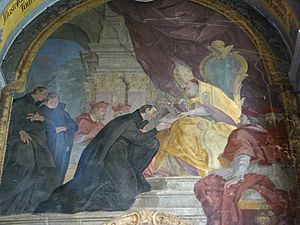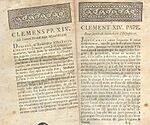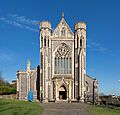Jesuits facts for kids
|
Latin: Societas Jesu
|
|

|
|
| Abbreviation | S.J. or SJ |
|---|---|
| Nickname | Jesuits |
| Formation | 27 September 1540 |
| Founders |
|
| Founded at | |
| Type | Order of clerics regular of pontifical right (for men) |
| Headquarters | Generalate: Borgo S. Spirito 4, 00195 Prati, Rome, Italy |
|
Region served
|
Worldwide |
|
Members
|
13,768 (2025) |
|
Motto
|
Latin: Ad Maiorem Dei Gloriam English: For the Greater Glory of God |
| Fr. Arturo Sosa, SJ | |
|
Patron saints
|
|
|
Ministry
|
Missionary, educational, literary works |
|
Main organ
|
La Civiltà Cattolica |
|
Parent organization
|
Catholic Church |
The Society of Jesus, also known as the Jesuits, is a group of priests and brothers in the Catholic Church. Their abbreviation is S.J. or SJ. The group was founded in 1540 by Ignatius of Loyola and six of his friends. Pope Paul III gave them his official approval. The Jesuits are the largest religious order in the Catholic Church.
Jesuits are famous for their work in education, charity, and helping people in need. They work as missionaries, teachers, and researchers in 112 countries. They also lead spiritual retreats, work in hospitals and local churches, and help with social projects.
The leader of the Jesuits is called the Superior General. The group's main headquarters is in Rome, Italy. Members of the society are sometimes called "God's soldiers" because their founder, Ignatius, had a military background. Their official motto is Ad Maiorem Dei Gloriam, which is Latin for "For the Greater Glory of God."
Contents
History of the Jesuits
How the Jesuits Began
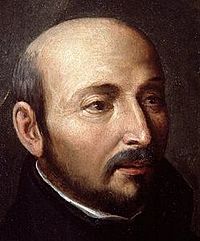
The Society of Jesus was founded by Ignatius of Loyola. He was a nobleman from the Basque region of Spain. After being injured in the Battle of Pamplona, he decided to dedicate his life to God.
On August 15, 1534, Ignatius and six friends met in a church in Paris, France. They promised to live in poverty and serve God. His friends included famous saints like Francis Xavier and Peter Faber. They called themselves the Compañía de Jesús, which means "Company of Jesus." The name was inspired by Ignatius's military past and the idea of being companions of Jesus.
In 1540, Pope Paul III officially approved the group with a document called a papal bull. This document is considered the founding charter of the Society of Jesus. Ignatius was chosen as the first leader, or Superior General.
The founding document stated that the society was created for anyone who wanted to serve as a "soldier of God." Their main goals were to defend and spread the Catholic faith and to help people grow in their Christian life.
Early Work of the Order
The first Jesuits focused on a few important activities. First, they opened schools all over Europe. Jesuit teachers were well-trained in many subjects, including classical studies and theology. Their schools became famous for providing excellent education.
Second, they sent missionaries around the world to spread Christianity. They traveled to places like Paraguay, Japan, and Ethiopia. One of the first Jesuits, Francis Xavier, traveled to India in 1541.
Third, they worked to stop the spread of Protestantism during a period called the Counter-Reformation. They encouraged people to remain loyal to the Catholic Church and the Pope.
Ignatius wrote the Jesuit Constitutions in 1553. These rules created a well-organized group that was ready to accept any mission from the Pope.
Spreading Across the World
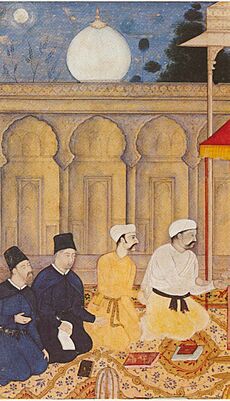
Jesuit missionaries traveled far and wide to share their faith. They had great success in Latin America, where they set up Christian communities called "reductions." These were self-sufficient towns where Indigenous people were protected from slavery and taught Christian values.
In Asia, Jesuits founded a college in Macau, China, in 1594. Missionaries like Matteo Ricci studied Chinese language and culture. They introduced Western science and astronomy to China. This work was very important, but it ended in the 18th century because of a dispute over Chinese customs.
Jesuits also went to North America. In Canada, they worked with the Huron people, learning their language and creating a dictionary. Sadly, many missionaries were killed during conflicts between native tribes.
Suppression and Restoration
In the 18th century, the Jesuits became very powerful and influential. Some European rulers saw them as a threat. Starting in 1759, Jesuits were forced out of many countries in Europe and their colonies.
In 1773, Pope Clement XIV officially suppressed, or disbanded, the entire order. This was a difficult time for the Jesuits. However, the order was not completely destroyed. It continued to exist in Russia, where the ruler, Catherine the Great, protected them.
In 1814, Pope Pius VII restored the Society of Jesus. After this, the order grew quickly again. They founded many new colleges and universities, especially in the United States.
The Jesuits Today
Today, the Jesuits are the largest religious order for men in the Catholic Church. As of 2025, there are about 13,768 members worldwide. They continue to focus on education, social justice, and missionary work.
The current Superior General is Arturo Sosa, who is from Venezuela. In 2013, a Jesuit, Cardinal Jorge Bergoglio, was elected Pope. He chose the name Pope Francis and was the first Jesuit ever to become Pope.
Jesuit ministries today have four main goals:
- To show people the way to God.
- To walk with the poor and those who are cast out.
- To help young people create a future full of hope.
- To help care for the planet, our "Common Home."
Jesuit Education
Jesuits are best known for their schools. They run hundreds of high schools, colleges, and universities around the world. These schools aim to provide excellent education while also teaching students to be "men and women for others."
Famous Jesuit universities in the United States include Georgetown University, Boston College, and Fordham University.
Jesuits in Science
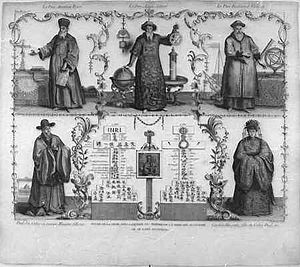
Throughout history, Jesuits have made important contributions to science. They have studied everything from astronomy to seismology (the study of earthquakes).
In the 17th and 18th centuries, Jesuits helped develop pendulum clocks, telescopes, and microscopes. They were among the first to observe the rings of Saturn and the Andromeda nebula. When they went to China, they shared Western knowledge of math, astronomy, and map-making.
Notable Jesuits
Many famous people have been Jesuits.
- Francis Xavier was one of the first Jesuits and a famous missionary in Asia.
- Matteo Ricci was a missionary to China who shared science and culture between East and West.
- Peter Claver was a missionary in South America who cared for enslaved Africans.
- Gerard Manley Hopkins was a famous English poet.
- Pope Francis is the first Jesuit to be elected Pope.
Images for kids
-
Francis Xavier was one of the first and most famous Jesuit missionaries.
-
José de Anchieta was a Spanish missionary who helped found the city of São Paulo in Brazil.
-
Matteo Ricci (left) and Xu Guangqi published a Chinese version of Euclid's Elements.
-
Francisco Javier Clavijero, a Mexican-born Jesuit who wrote an important history of Mexico.
-
Samuel Fritz's 1707 map showing the Amazon and the Orinoco WDL1137.png
A 1707 map of the Amazon River region made by Jesuit missionary Samuel Fritz.
-
Jesuit priest Alfred Delp was part of the resistance against the Nazis in Germany.
Gallery of Jesuit churches
-
The Church of the Gesù in Rome, is the mother church of the Jesuits.
-
Loyola University Chicago Art Deco Chapel at Lakeshore Campus, Chicago, Illinois, US
-
The Santa Clara University's Mission Church is at the heart of Santa Clara University's historic campus Santa Clara, California, US.
-
St. Ignatius Church, parish church of the University of San Francisco, San Francisco, California, US
-
The Church of the Gesu in Frascati, province of Rome, Italy
-
Jakarta Cathedral, Indonesia
-
Sacred Heart Church, Wimbledon, London
- Ad maiorem Dei gloriam
- Apostleship of Prayer
- Blas Valera
- Bollandist
- Canadian Indian residential school system
- Church of the Mission of France
- Jesuit conspiracy theories
- Jesuit Ivy
- Jesuit missions among the Guaraní
- Jesuit Missions of Chiquitos
- Jesuit Refugee Service
- List of Jesuit sites
- List of saints of the Society of Jesus
- Misiones Province
- Monumenta Historica Societatis Iesu
- Igreja de São Roque
- Thomas Weld (of Lulworth)
See also
 In Spanish: Compañía de Jesús para niños
In Spanish: Compañía de Jesús para niños


